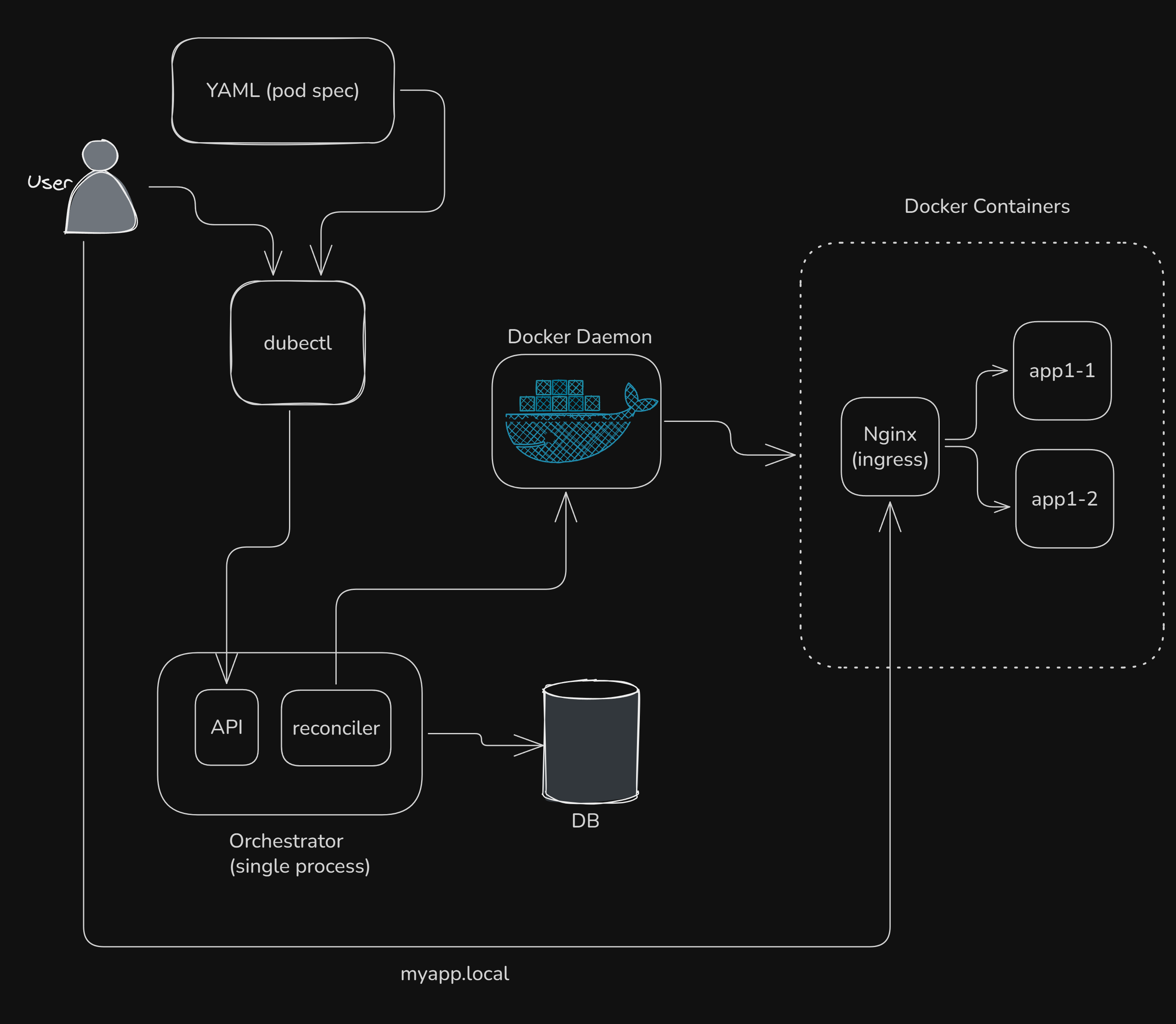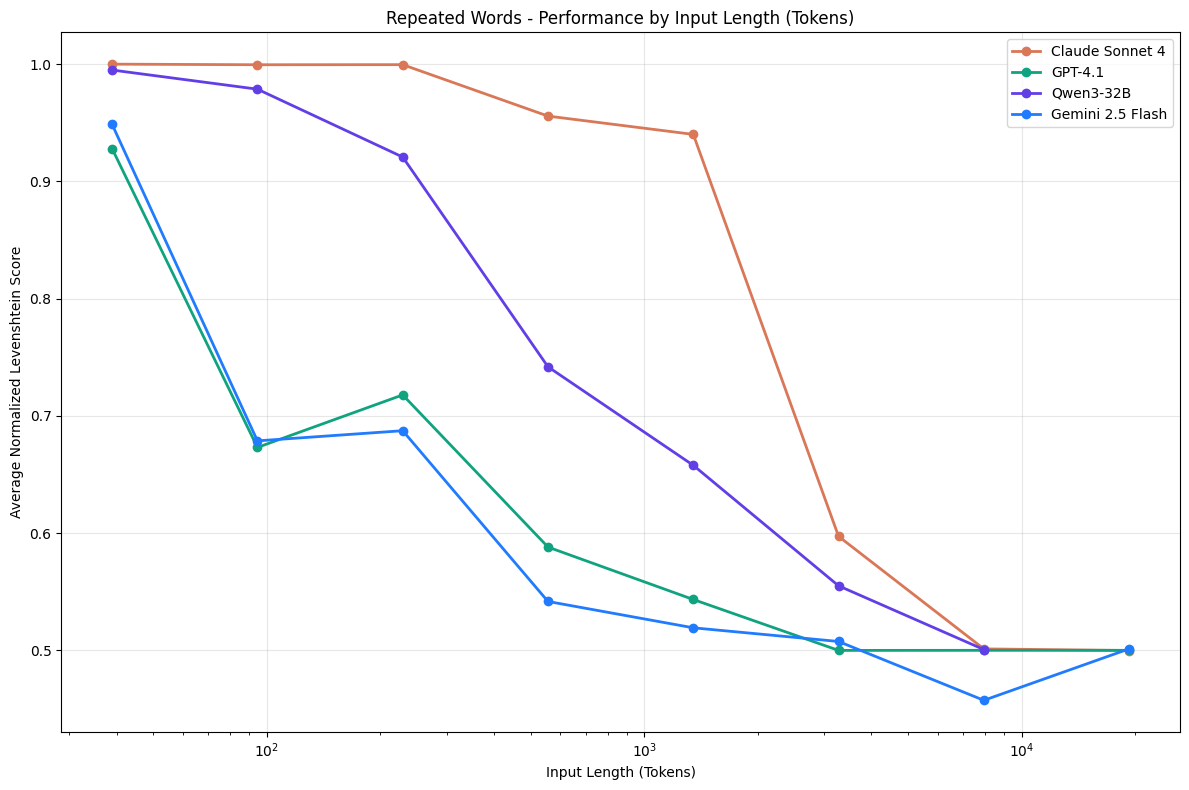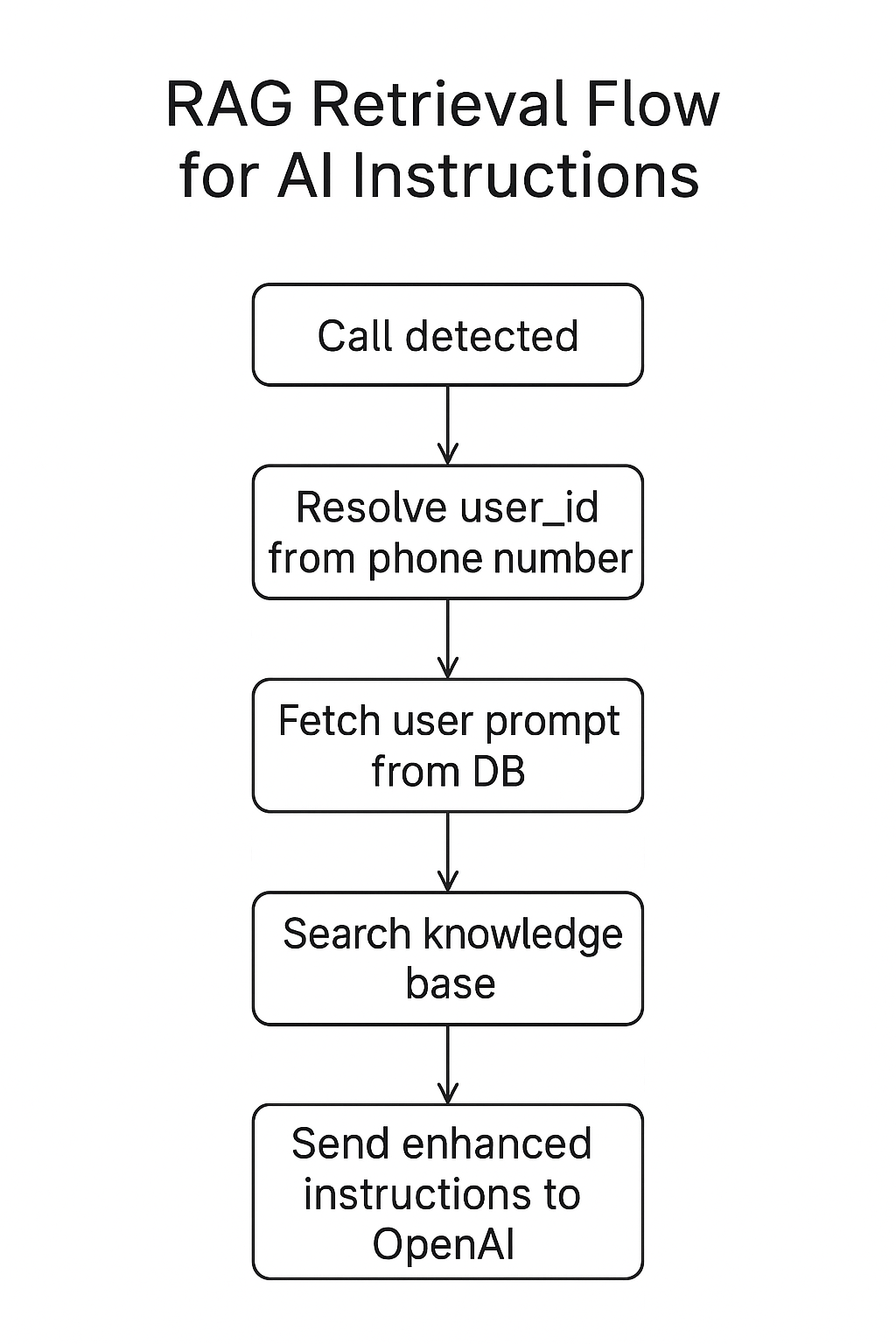TL;DR Give me code
Alright. Here https://github.com/MansoorMajeed/Dubernetes
But Why?
A while ago I wrote about how Kubernetes runs containers under the hood
How Kubernetes Runs Containers : A Practical Deep Dive
Taking a deep dive into how Kubernetes runs containers as Linux processes
 Esc.shMansoor
Esc.shMansoor

And this was my "dumb architecture" from that article

So I thought, why don't I vibe code a dumb one? It could be a valuable resource for someone learning container orchestration. I initially thought of writing it by myself, but a quick look at my graveyard of half-baked projects convinced me otherwise.
Requirements - How should it work?
I want to write down a desired state for my app in a yaml file, use a command line tool similar to kubectl and Dubernetes should then use that to create Docker containers to run my application.
The Yaml should be something like this
name: myapp image: myapp-image:latest replicas: 3 access: host: myapp.localIt is as simple as it can be
- Give a name
- Specify a docker image to run (no sidecars in Dubernetes sorry)
- Specify how many replicas (docker containers)
- Expose it via a domain name (Built-in ingress)
Building it
Step 1 : Deciding on the basics
- Language : When it came to the language, was there ever any doubt? It had to be Go. It’s the native tongue of Kubernetes and is fantastic for building the kind of system-level tools like Dubernetes
- AI Assistant: I decided to go with Claude code
Step 2: Brainstorming with Claude Code
I spent a bit of time talking to Claude about what we are going to build. We discussed about the yaml structure, and the need for keeping everything simple. Initially it suggested a whole lot of complicated features. But added the following lines in CLAUDE.md to curb Claude's enthusiasm a little bit
Design GoalsMaximum Simplicity: One orchestrator, one proxy, minimal components
Learning Focus: Understand orchestration without enterprise complexity
Claude can be opinionated if you don't drive the conversation. So be very vocal about your vision and you will of course be bombarded with the classic You're absolutely right

Take as much time as needed in this step. Make sure to not overload the context with unnecessary information.
Coming up with a high level architecture
After talking to claude for some time, we came up with an architecture.
You can find the detailed architecture here. Here is a high level view of the overall system
 dubernetes architecture
dubernetes architecture- A single binary Orchestrator
- It has API endpoints where the user can make requests about the desired state of the containers (more on this later)
- This state is stored in an SQLite database
- It will have a reconciler component that will run in a loop and make sure that the actual state of the running containers matches the desired state in the database
- It uses the docker command to manage docker containers on the host machine
- dubectl the command line tool for the user to interact with the API
- An in built Nginx container that act as an ingress to route traffic from outside the "cluster"
Step 3 : Creating an implementation plan
Once the architecture is clear, next step was to have Claude create an implementation plan.
I wanted to make sure that with each change, Claude will not break existing functionality. So I decided to go with Test Driven Development
Building Dubernetes using Test-Driven Development (TDD) approach. Each phase starts with writing tests, then implementing the functionality to make tests pass.So we wrote down the implementation plan into a markdown file. You can find that HERE
At this point I also made sure to update the CLAUDE.md to reflect these documents and the vision. Check it out HERE
Step 4 : Session Continuity made easy!
After creating a clear direction, I asked claude to use a markdown file PROJECT_STATUS.md to keep the status updated after each session. Exact instruction in CLAUDE.md
**Session Continuity** Status File: PROJECT_STATUS.md - Contains current progress and context Resume Protocol: When starting new sessions, check PROJECT_STATUS.md for: - Current implementation phase - Completed tasks and checklist status - Active development context - Next steps and priorities - Key Design PrinciplesAdditionally, this line
When user says "let us wrap up for the day", update PROJECT_STATUS.md with current progress and context for seamless session resumption.Step 5: Vibe!!
Once the plan was locked in, I stepped back and let Claude handle the implementation.! I did not look at the code, not even once!
Step 6 : Reset often
After finishing a milestone (tests passing – both manual and unit), commit it, have Claude update the PROJECT_STATUS and /reset to free up context! I found that this simple act made Claude very consistent.
 no memory
no memoryWhile you might think you have ample context window to spare, an LLM's performance actually degrades significantly as the context grows, well before reaching the advertised maximum. There's a sharp drop-off, which this graph illustrates perfectly.

Source: https://research.trychroma.com/context-rot#results
The Code Flow
Step 1 : The Yaml
Let's take the previous example yaml
name: myapp image: myapp-image:latest replicas: 3 access: host: myapp.localWe want the myapp-image:latest docker container to run with 3 containers and have it respond at the domain myapp.local
Step 2 : Applying it using dubectl
PodSpec looks like this
cmd/dubectl/types.go
type PodSpec struct { Name string `yaml:"name" json:"name"` Image string `yaml:"image" json:"image"` Replicas int `yaml:"replicas,omitempty" json:"replicas,omitempty"` Access *AccessSpec `yaml:"access,omitempty" json:"access,omitempty"` }The CLI tool Makes an API call
cmd/dubectl/types.go
// CreatePod creates a new pod via the API func (c *APIClient) CreatePod(podSpec *PodSpec) error { // Convert PodSpec to API request format requestData := map[string]interface{}{ "name": podSpec.Name, "image": podSpec.Image, "replicas": podSpec.Replicas, }Step 3 : The Orchestrator API receives the request
pkg/api/handlers.go
Upon receiving the POST request, orchestrator does some validation and calls CreatePod
// createPod handles POST /pods func (h *Handler) createPod(w http.ResponseWriter, r *http.Request) { // ----snip----- // Create pod pod, err := h.orchestrator.CreatePod(r.Context(), req) if err != nil { h.writeError(w, http.StatusInternalServerError, "failed to create pod", "CREATE_FAILED", err.Error()) return } }cmd/orchestrator/main.go
// CreatePod creates a new pod // Simply creates a database entry for the pod func (o *OrchestratorImpl) CreatePod(ctx context.Context, req api.PodRequest) (*api.PodResponse, error) { //-----snip----- // Convert API request to database pod dbPod := &database.Pod{ Name: req.Name, Image: req.Image, Replicas: replicas, DesiredState: "running", CreatedAt: time.Now(), UpdatedAt: time.Now(), } err := o.db.CreatePod(dbPod) if err != nil { return nil, err } //-----snip----- }Step 4 : Reconciler creates containers
pkg/reconciler/reconciler.go
Finally, create the docker container, update Ingress nginx configuration
// ReconcileOnce performs a single reconciliation cycle func (r *Reconciler) ReconcileOnce() error { // Get all pods from database // Reconcile each pod // Update nginx configuration } // reconcileRunningPod ensures a pod has the correct number of running replicas func (r *Reconciler) reconcileRunningPod(pod *database.Pod, replicas []*database.Replica) error { runningReplicas := 0 var replicasToRestart []*database.Replica // Count running replicas and identify failed ones // Restart failed replicas // Remove excess replicas if needed // Create additional replicas if needed } func (r *Reconciler) createReplica(pod *database.Pod) error { // Allocate port // Generate replica ID // Create replica record first // Create container req := &docker.RunContainerRequest{ Image: pod.Image, Name: replicaID, Port: port, Labels: map[string]string{ "dubernetes.pod": pod.Name, "dubernetes.replica": replicaID, }, } containerID, err := r.docker.RunContainer(req) }Running it!
Build and start the orchestrator
make build ./bin/orchestrator &Run a demo pod
./bin/dubectl apply -f examples/whoami-service.yaml app running as docker containers
app running as docker containersWe can see that the 3 app containers and the nginx (which acts as the ingress) container running
Making a request
We can make a request using curl and the --resolve flag to map the domain whoami.local to 127.0.0.1, letting us send a proper request as if the hostname resolved normally
$ curl localhost --resolve whoami.local:80:127.0.0.1 Hostname: 53b4ab629c3e IP: 127.0.0.1 IP: ::1 IP: 172.17.0.3 RemoteAddr: 172.17.0.2:42188 GET / HTTP/1.1 Host: localhost User-Agent: curl/8.7.1 Accept: */* Connection: close X-Forwarded-For: 192.168.65.1 X-Forwarded-Proto: http X-Real-Ip: 192.168.65.1okay it works!
Conclusion
It turned out to be surprisingly easy to vibe-code the whole thing without Claude melting down. I think the main reason was sticking to test-driven development and regularly resetting the context. I had a ton of fun and I hope you had a decent read too!
.png)




